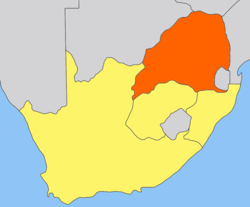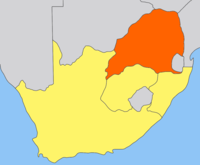Transvaal Colony: Difference between revisions
81.153.180.50 (talk) No edit summary |
81.153.180.50 (talk) No edit summary |
||
| Line 22: | Line 22: | ||
|image_map_caption = Location of the Transvaal in pre-1994 South Afica |
|image_map_caption = Location of the Transvaal in pre-1994 South Afica |
||
|national_anthem = [[Transvaalse Volkslied]] |
|national_anthem = [[Transvaalse Volkslied]] |
||
|common_languages = |
|common_languages = [[English language|English]], [[Afrikaans language|Afrikaans]] |
||
|religion = Dutch Reformed Church |
|religion = Dutch Reformed Church |
||
|capital = [[Pretoria]] |
|capital = [[Pretoria]] |
||
{{coor dm|25|43|S|28|14|E|}} |
{{coor dm|25|43|S|28|14|E|}} |
||
|government_type = Republic |
|government_type = Republic |
||
|title_leader = |
|title_leader = |
||
|leader1 = |
|leader1 = |
||
|year_leader1 = |
|year_leader1 = |
||
|leader2 = |
|leader2 = |
||
|year_leader2 = |
|year_leader2 = |
||
|leader3 = |
|leader3 = |
||
|year_leader3 = |
|year_leader3 = |
||
|event_start = |
|event_start = |
||
|event_end = [[Treaty of Vereeniging]] |
|event_end = [[Treaty of Vereeniging]] |
||
Revision as of 20:15, 14 April 2008
Transvaal | |||||||||||||
|---|---|---|---|---|---|---|---|---|---|---|---|---|---|
| 1902–1994 | |||||||||||||
| Anthem: Transvaalse Volkslied | |||||||||||||
 Location of the Transvaal in pre-1994 South Afica | |||||||||||||
| Capital | Pretoria 25°43′S 28°14′E / 25.717°S 28.233°E | ||||||||||||
| Common languages | English, Afrikaans | ||||||||||||
| Religion | Dutch Reformed Church | ||||||||||||
| Government | Republic | ||||||||||||
| History | |||||||||||||
• Established | 1902 | ||||||||||||
• British annexation | 1877-1881 | ||||||||||||
| October 11, 1899 | |||||||||||||
| 1994 | |||||||||||||
| |||||||||||||


- For the Russian theme park, see Transvaal Park.
The Transvaal (lit. beyond the Vaal [pale river]) is the name of an area of northern South Africa. Originally the bulk of the independent Boer South African Republic, after the Anglo-Boer War of 1899-1902 it became the Transvaal Colony, and one of the founding provinces of the Union of South Africa from 1910 until 1994 with capital in Pretoria. The province no longer exists, and its territory now forms the provinces of Gauteng, Limpopo and Mpumalanga and part of the North West Province. While it no longer exists as an administrative unit, the Transvaal is still a commonly used geographical term and retains its historical meaning.
History
- Main article: South African Republic
The Transvaal was colonised by Boer settlers who exited the British-dominated Cape Colony in the 1830s and 1840s in the Great Trek and established several republics outside British control - after the British occupation of the former Dutch colony in 1795 and again in 1806. The Great Trek came about due to discontent with autocratic British rule, lack of protection against raiding Xhosa bands, and Anglicisation of established Dutch traditions. Moving north-east, 'behind' the Nguni societies (Xhosa and Zulu), the voortrekkers first established the independent republic, Natalia, but were again occupied by the British in 1843. They moved on across the Orange river, and established Transoranje in 1845 (later Orange Free State) but were again occupied by the British. Finally, they moved further north and established a number of smaller republics across the Vaal river, Transvaal, later to be united in the Zuid Afrikaanse Republiek - ZAR.
The trekkers took advantage of the vast empty areas left after the Zulu extermination wars and their repercussions, and easily overcame the native peoples. In the 1850s, the British came to an understanding with the Boer republics, granting independence to the South African Republic (ZAR) in what is now the Transvaal. Britain annexed the ZAR again in 1877 as a convenient way of resolving the border dispute between the Boers and the Zulus. This also saved the Transvaal from financial ruin, as the government had completely run out of money. It regained its independence in 1881 after the so-called First Boer War.
Beginning in 1885, the discovery of a tremendous lode of gold in the Witwatersrand led to the immigration of many foreigners (uitlanders) to the Transvaal. The economic development of the Transvaal soon became staggering, and it was only a matter of short time before Transvaal would overtake the (British controlled, but Boer dominated) Cape Colony and possibly throw the British Empire out of southern Africa. Furthermore, the longer this gold remained out of British control, the position of London as centre of the world's gold trade (in the days of the international Gold Standard) was threatened, and thereby also London's position as the world's financial centre and role as a listening station for Empire intelligence. Using Uitlander franchise as a pretext, Britain therefore planned a takeover of Transvaal, as a parallel to her takeover of the (former Orange Free State) immense diamond fields in Kimberley. The Jameson Raid was an attempted coup d'etat in 1895, and was financed by the (foreign) mine owners who were dissatisfied with the Boer's taxation and restriction on the business. The raid was an awakening for the Boers and led to massive armament, mainly from German suppliers.
Increasing fear of British designs on the region and the amassing of British forces on their borders) led the Boers to make a pre-emptive strike in 1899. The Second Boer War lasted until 1902 and Britain used 500 000 soldiers against approximately 64 000 Boers. Women and children of the Boers were put in concentration camps and approximately 26 000 died due to malnutrition and poor hygienic standards. This demoralising fact coupled with the use of torched earth strategy, and a blockade built through the entire country forced the Boer "Commandos" into submission. The war resulted in the incorporation of the Transvaal into the British Empire in 1902. The war also had immense effects on British politics both domestically, in Europe and the Empire, as it became evident that the Empire was more vulnerable than assumed. The Anglo-Boer war was in many senses a rehearsal for the greater events starting in 1914.
Eight years later, the Boer republics joined with the Cape Colony to form the Union of South Africa.
In 1961, the union ceased to be part of the Commonwealth of Nations and became the Republic of South Africa. The PWV (Pretoria-Witwatersrand-Vereeniging) area in the Transvaal became South Africa's economic powerhouse, a position it still holds today.
In 1994, after the fall of apartheid, the former provinces and homelands were restructured, and a separate Transvaal province no longer exists. Parts of the old Transvaal now belong to the new Gauteng, North West, Limpopo and Mpumalanga provinces.
The Transvaal is still used as a provincial division of the High Court of South Africa, as of 2006.
Even before 1994 the Transvaal province was split into regions for a number of reasons (sports for one), into Northern Transvaal (Pretoria, and Limpopo province now), Eastern Transvaal (Mpumalanga province now), Western Transvaal (Northwest province now) and Southern Transvaal (Gauteng province now, excluding Pretoria)
Geography
The Transvaal province lay between Vaal River in the south, and the Limpopo River in the north, roughly between 22 1/2 and 27 1/2 S, and 25 and 32 E. To its south it bordered with the Orange Free State and Natal provinces, to its west were the Cape Province and the Bechuanaland Protectorate (later Botswana), to its north Rhodesia (later Zimbabwe), and to its east Portuguese East Africa (later Mozambique) and Swaziland. Except on the south-west, these borders were mostly well defined natural features.
Several Bantustans were entirely inside the Transvaal: Venda, KwaNdebele, Gazankulu, KaNgwane and Lebowa. Parts of Bophuthatswana were also in the Transvaal, with other parts in Cape Province and Orange Free State.
Within the Transvaal lies the Waterberg Massif, a prominent ancient geological feature of the South African landscape.
Divisions:
Cities in the Transvaal:
See also
- Flag of Transvaal
- History of South Africa
- Transvaal map[1]
References
- This article incorporates text from a publication now in the public domain: Chisholm, Hugh, ed. (1911). Encyclopædia Britannica (11th ed.). Cambridge University Press.
{{cite encyclopedia}}: Missing or empty|title=(help)



